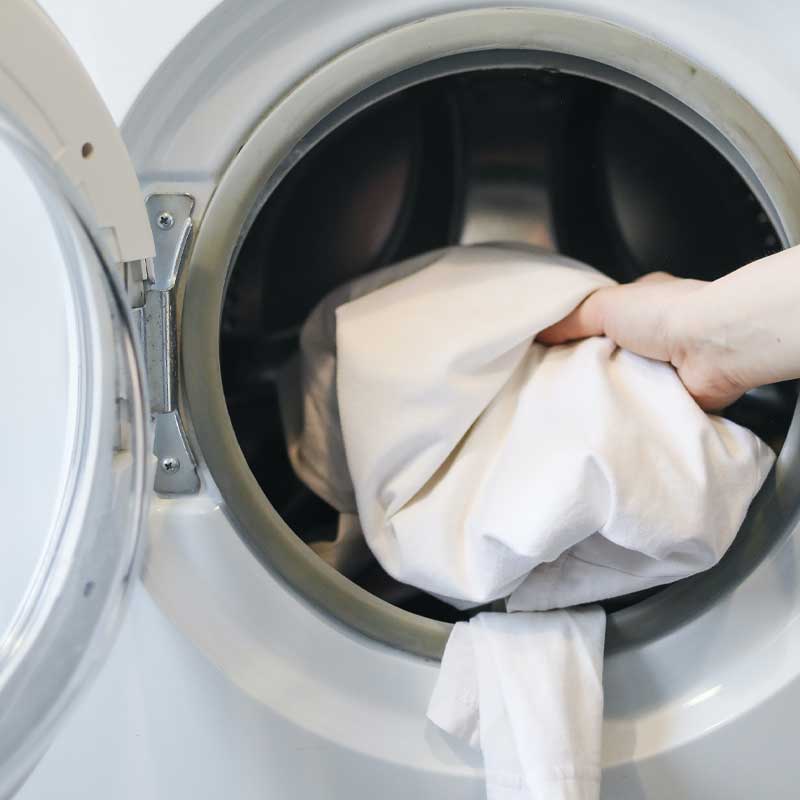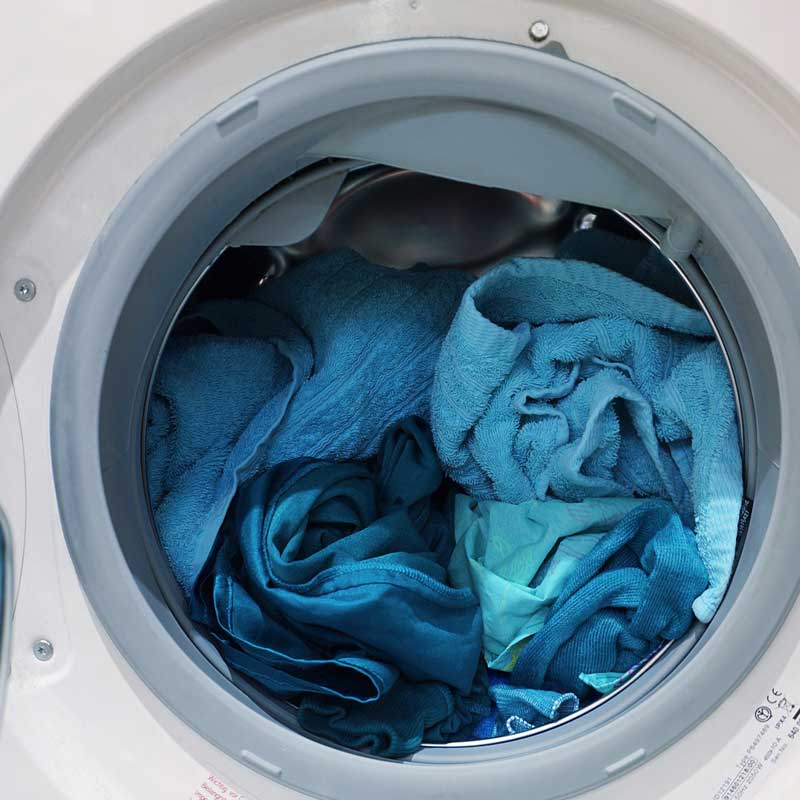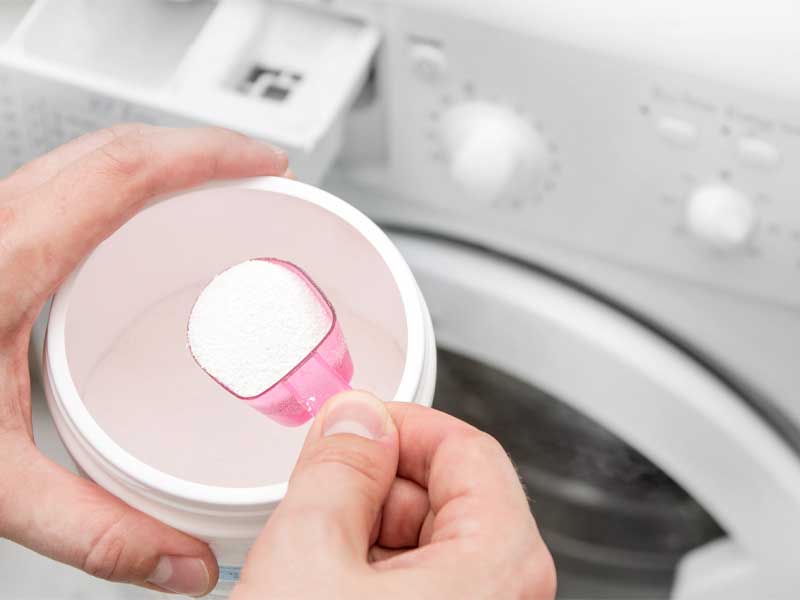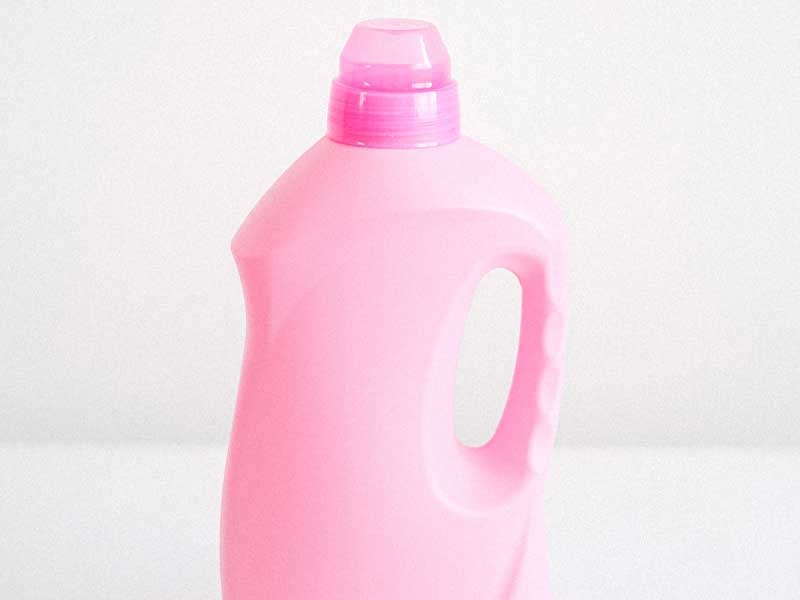Laundry Tips
Oxygen bleach is an emerging tool in the arsenal of a modern drycleaner, and wet cleaning, using eco-friendly enzyme detergents and colorfast oxygen bleach, is a rapidly growing segment in our industry. Unlike your mother’s traditional chlorine bleach (sodium hypochlorite), oxygen bleach uses the gentler sodium percarbonate* to whiten whites and brighten colors. In addition to being odorless and colorless, oxygen bleach has stain removal properties, but remember that oxygen bleach is a detergent additive, and it must work in tandem with a laundry detergent to achieve the most favorable result. As you’ll see below, optical brighteners are typically included in color-safe oxygen bleach detergent additives. This ingredient is like an invisible layer on fabrics that reflects light, making colors appear brighter and whites whiter.
Our washing machines are electronically controlled to draw the appropriate blend of enzyme detergent and colorfast bleach for each type of wet cleaning load, and though our certifications and awards suggest we’re among the best at what we do, there are principles that you can follow to improve the results you achieve in your washing machine at home. Since we’re using some tips from The Clorox Company on this page and others, it’s only fair to mention that Clorox offers multiple oxygen bleach detergent additives under their OxiClean trademark, but there are other options available to you. Just look for the words ‘Colorfast’ and/or ‘Chlorine Free’ and you’ll be at the right place in the shopping aisle.
* Mixed with water in liquid form, the contents break down to hydrogen peroxide—an eco-friendly combination of water and oxygen plus sodium carbonate (commonly known as washing soda or soda ash).
Sorting Clothes Avoids Most Laundry Problems
Even in an all-baby-clothes washload it’s important to sort clothing to prevent more work for you later. Sort loads by:
- Color
- Whites and pastels together.
- Same-color brights.
- Dark colors together
- Multicolored clothes that have lots of white and dark colors are best washed separately the first time. If the dye does not bleed or run it can be washed along with whites the next time.
- Fabric Type
- Separate delicate or lightweight fabrics from heavy ones.
- Lint producers (towels) from lint attractants (corduroy)
- Heavily Soiled
- These clothes need special treatment. Always wash soiled diapers separately because they have very high levels of bacteria.
Washing Tips
When one or more of the following factors is out of balance, dull or dingy clothes are often the result.
- Use the warmest water recommended for fabric – Hot water cleans better than cold. Cold water is fine for rinsing.
- Don’t scrimp on detergent or laundry additives. Measure, don’t guess. For heavily soiled clothes, more may be needed.
- Avoid overloading the machine. Also set water level high enough so that clothes have plenty of room to circulate and rinse properly. You want to make sure dirt and detergent go down the drain, not back on the clothes.

Washing Tips
When one or more of the following factors is out of balance, dull or dingy clothes are often the result.
- Use the warmest water recommended for fabric – Hot water cleans better than cold. Cold water is fine for rinsing.
- Don’t scrimp on detergent or laundry additives. Measure, don’t guess. For heavily soiled clothes, more may be needed.
- Avoid overloading the machine. Also set water level high enough so that clothes have plenty of room to circulate and rinse properly. You want to make sure dirt and detergent go down the drain, not back on the clothes.

Drying Tips
- To make sure stains are gone, air-dry stained clothes first. Dryer heat can permanently set some stains. If stains remain, treat and wash again..
- Avoid overloading the dryer. Clothes take longer to dry and wrinkle more.
- Don’t overdry clothes. Overdrying can increase wrinkles and shrinkage. Remove stretch items from the dryer when just barely dry.
- Air-dry plastic pants, bibs and rubber items. Heat can cause rubber to deteriorate and plastic to harden.
- Remove clothes as soon as they’re dry. Hang or fold right away to prevent wrinkles and time-consuming ironing.

Drying Tips
- To make sure stains are gone, air-dry stained clothes first. Dryer heat can permanently set some stains. If stains remain, treat and wash again..
- Avoid overloading the dryer. Clothes take longer to dry and wrinkle more.
- Don’t overdry clothes. Overdrying can increase wrinkles and shrinkage. Remove stretch items from the dryer when just barely dry.
- Air-dry plastic pants, bibs and rubber items. Heat can cause rubber to deteriorate and plastic to harden.
- Remove clothes as soon as they’re dry. Hang or fold right away to prevent wrinkles and time-consuming ironing.

Bleach
You can keep washables whiter and brighter longer when bleach is used in every washload. Choosing the right bleach is easy. Household liquid bleach, identified by the words “sodium hypochlorite” in the ingredient listing is the only bleach that disinfects. It is also the most effective bleach for stain removal and whitening. This is the bleach of choice for whites and colorfast garments.- It pays to do the bleach-safe test when you think a garment should be bleachable. Clorox laundry studies confirm that about 52% of all washables are actually safe with household liquid bleach.
- Other laundry studies show how liquid bleach is safe for fabrics, when used as directed. This bleach does not wear down fabrics any more than detergent alone, washload after washload.
- Color-Safe Bleach is, quite simply, a bleach that is safe to use on washable, colored clothes. These bleaches, available in powder and liquids, remove stains and help keep colors bright. The powdered bleaches also have enzymes to break up tough protein stains, which is why they make an excellent presoak.
- A color-safe bleach is not a diluted bleach. The gentle bleaching action in liquids is from hydrogen peroxide. Powders commonly use sodium perborate.
- These color-safe bleaches also have optical brighteners. This ingredient is like an invisible layer on fabrics. It reflects light, making colors appear brighter and whites whiter.

Bleach
You can keep washables whiter and brighter longer when bleach is used in every washload. Choosing the right bleach is easy. Household liquid bleach, identified by the words “sodium hypochlorite” in the ingredient listing is the only bleach that
disinfects. It is also the most effective bleach for stain removal and whitening. This is the bleach of choice for whites and colorfast garments.
- It pays to do the bleach-safe test when you think a garment should be bleachable. Clorox laundry studies confirm that about 52% of all washables are actually safe with household liquid bleach.
- Other laundry studies show how liquid bleach is safe for fabrics, when used as directed. This bleach does not wear down fabrics any more than detergent alone, washload after washload.
- Color-Safe Bleach is, quite simply, a bleach that is safe to use on washable, colored clothes. These bleaches, available in
powder and liquids, remove stains and help keep colors bright. The powdered bleaches also have enzymes to break up tough protein stains, which is why they make an excellent presoak. - A color-safe bleach is not a diluted bleach. The gentle bleaching action in liquids is from hydrogen peroxide. Powders commonly use sodium perborate.
- These color-safe bleaches also have optical brighteners. This ingredient is like an invisible layer on fabrics. It reflects light, making colors appear brighter and whites whiter.

Adding Bleach to Your Washer
Many washing machines today are equipped with convenient automatic bleach dispensers for household liquid bleach. If a washer is not equipped with a liquid bleach dispenser follow either of these two methods:
- For maximum cleaning results:
- Add detergent as washer fills, then add clothes.
- After machine has agitated for 5 minutes, add household liquid bleach that has been diluted in 1 quart of water. Avoid pouring mixture directly onto clothes.
Note: Always use this method when using detergent with bleach products.
- Convenient and effective
- While the machine fills with water, pour in liquid bleach and detergent.
- Once agitation begins, add clothes.

Adding Bleach to Your Washer
Many washing machines today are equipped with convenient automatic bleach dispensers for household liquid bleach. If a washer is not equipped with a liquid bleach dispenser follow either of these two methods:
- For maximum cleaning results:
- Add detergent as washer fills, then add clothes.
- After machine has agitated for 5 minutes, add household liquid bleach that has been diluted in 1 quart of water. Avoid pouring mixture directly onto clothes.
Note: Always use this method when using detergent with bleach products.
- Convenient and effective
- While the machine fills with water, pour in liquid bleach and detergent.
- Once agitation begins, add clothes.

Prewash Soil and Stain Removers
- These products are formulated to help get clothes stain free. Their special detergents and enzymes penetrate stains and break them up, helping detergents work more effectively to wash stains away.
Fabric Softeners
- Fabric softeners help reduce static cling, minimize wrinkling and soften clothes. Rinse-added softeners are added to the final rinse cycle. These can be added automatically in washers equipped with a fabric softener dispenser. Otherwise, diluted softener must be added manually to the final rinse. Dryer sheets are convenient to use with one sheet added to the dryer along with the clothes.

Prewash Soil and Stain Removers
- These products are formulated to help get clothes stain free. Their special detergents and enzymes penetrate stains and break them up, helping detergents work more effectively to wash stains away.
Fabric Softeners
- Fabric softeners help reduce static cling, minimize wrinkling and soften clothes. Rinse-added softeners are added to the final rinse cycle. These can be added automatically in washers equipped with a fabric softener dispenser. Otherwise, diluted softener must be added manually to the final rinse. Dryer sheets are convenient to use with one sheet added to the dryer along with the clothes.

Shirts $2.89
Dry Cleaning $4.39
